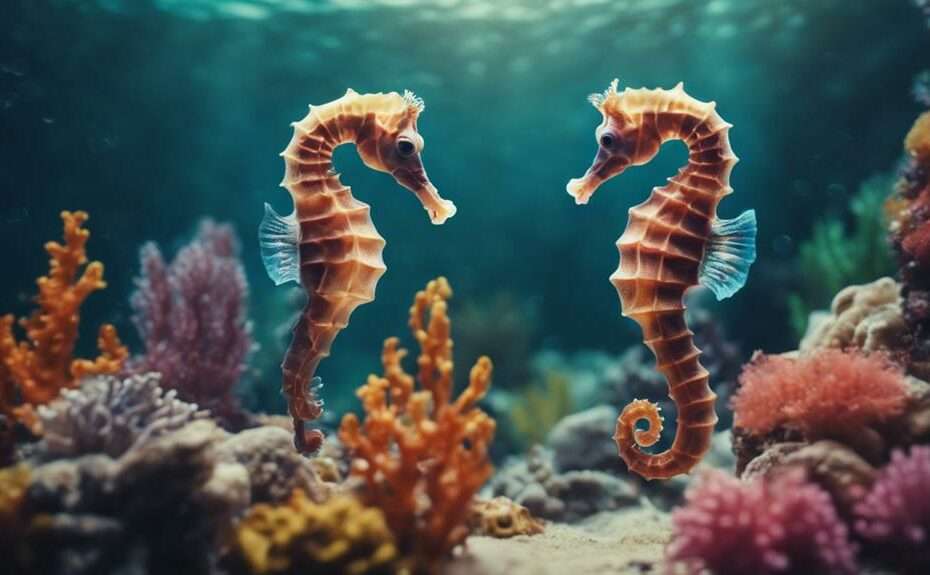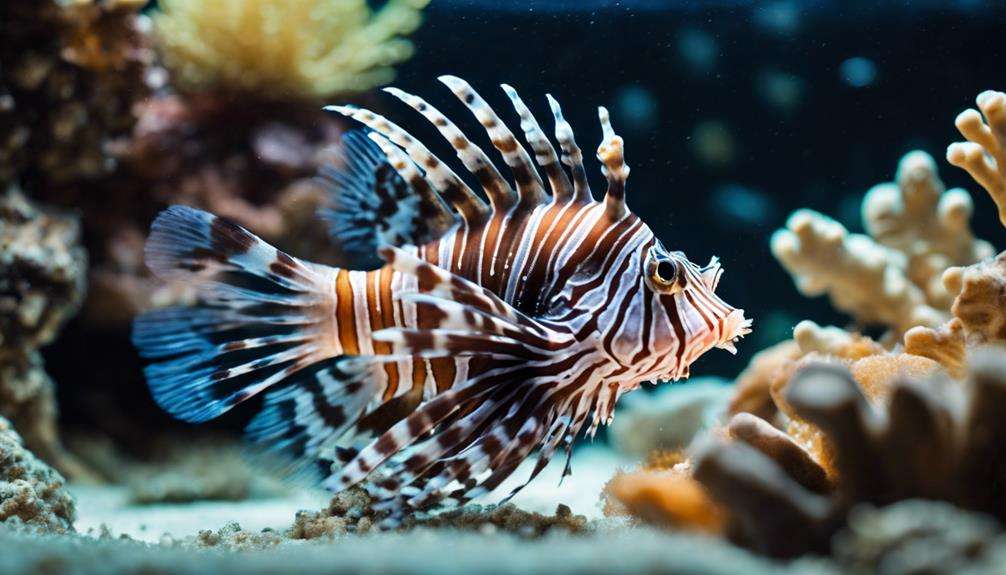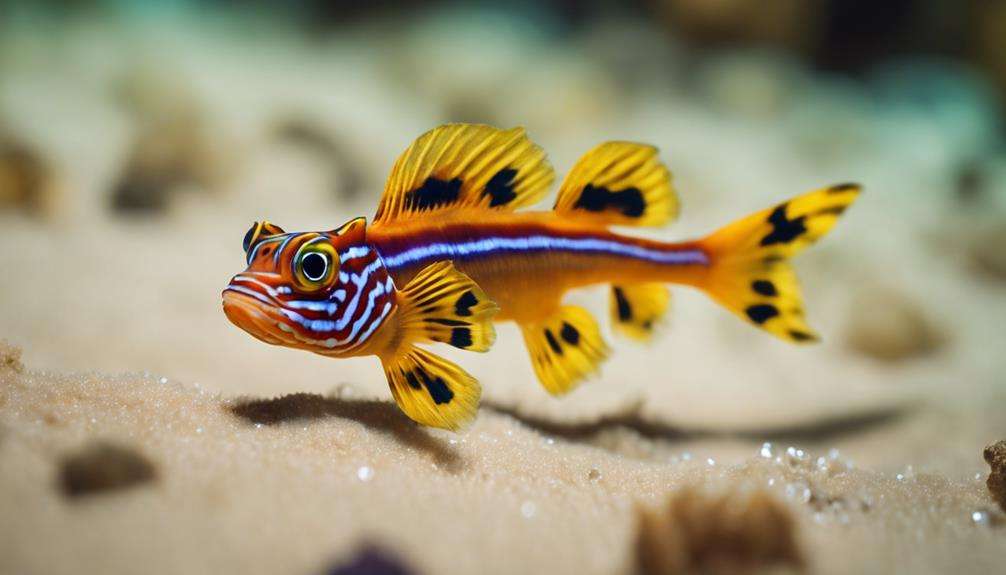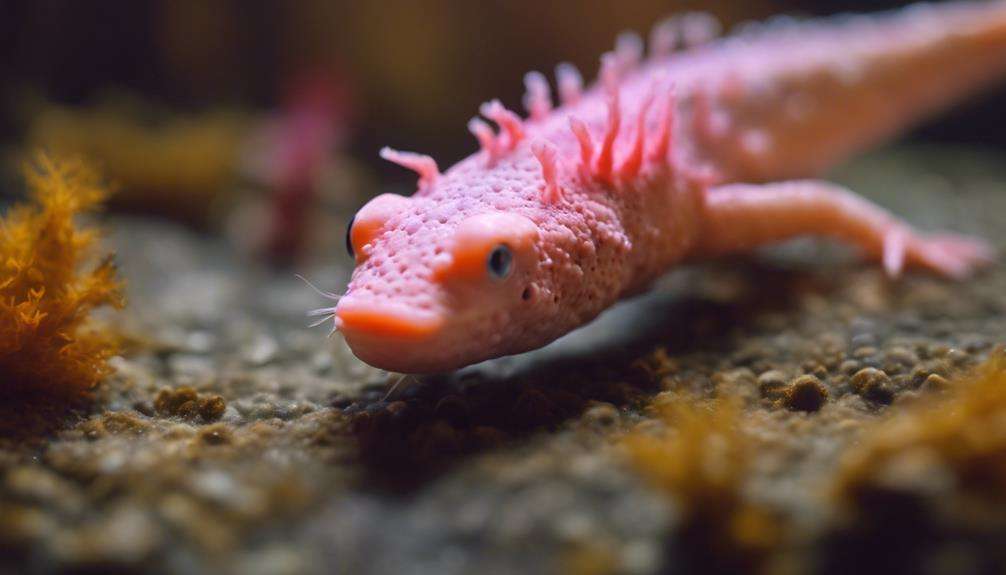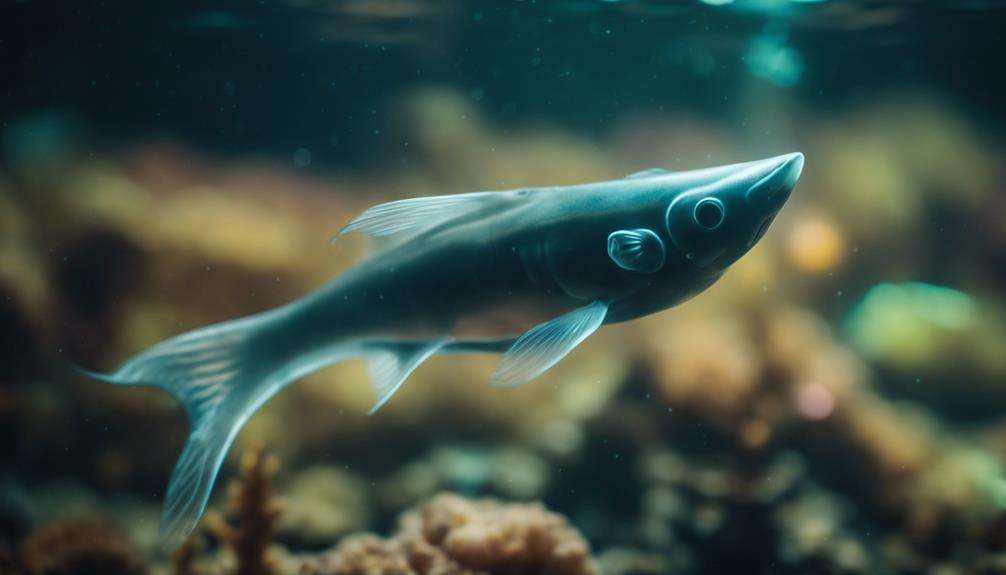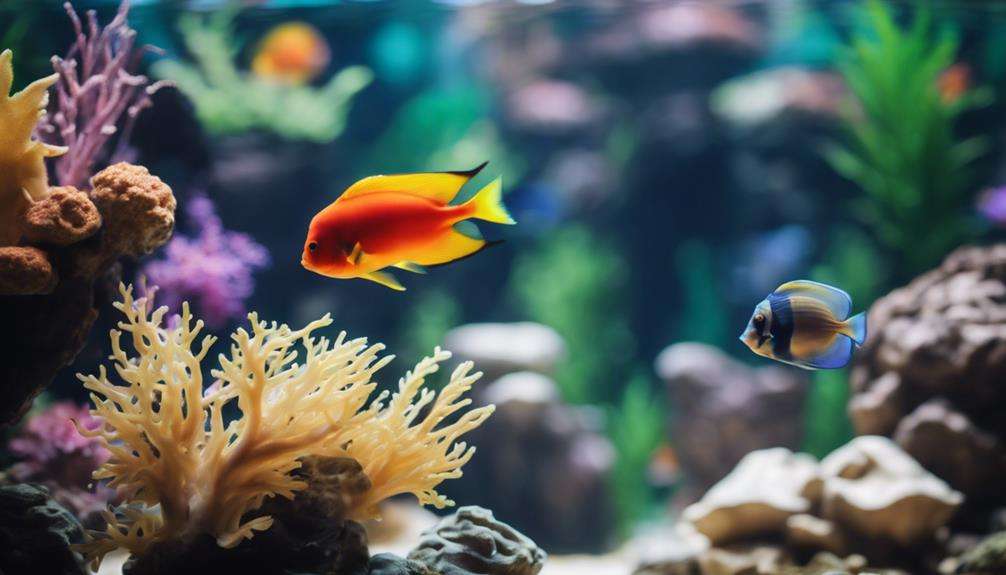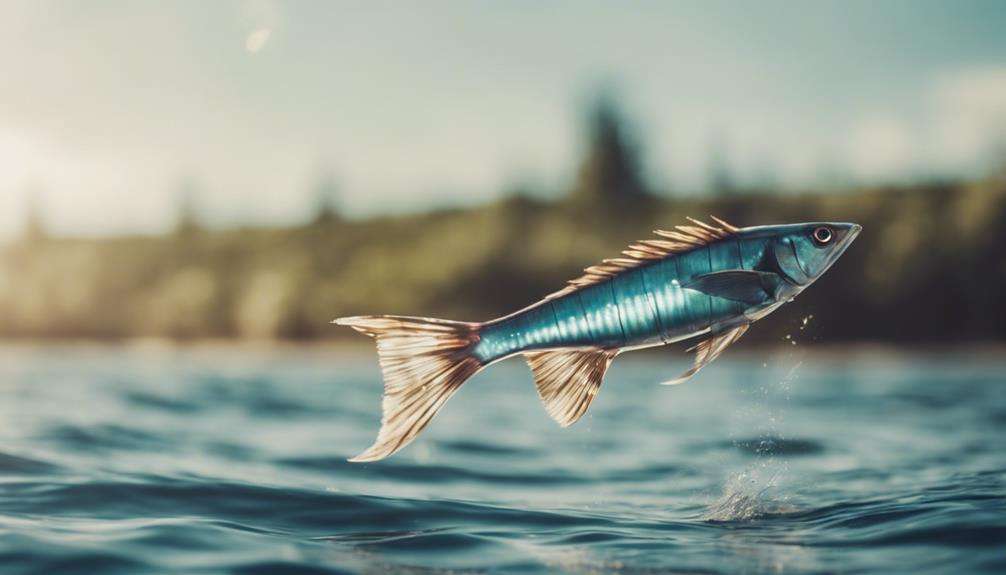Have you ever wondered how to master the art of seahorse breeding with expert techniques?
Discover the hidden secrets behind successful seahorse reproduction and explore the intricate world of nurturing these majestic creatures.
Unravel the complexities of their unique breeding behaviors and gain valuable insights into creating the perfect environment for seahorse propagation.
Dive into the realm of seahorse breeding mastery and unlock the knowledge that will revolutionize your approach to caring for these enchanting marine animals.
Key Takeaways
- Properly condition male seahorses with nutrient-rich diets for successful breeding.
- Allocate adequate tank space to promote natural behaviors and prevent stress.
- Choose peaceful tank companions like gobies and invertebrates for breeding success.
- Maintain optimal water quality and equipment for aeration to support seahorse health and breeding.
Seahorse Brood Stock Conditioning
To ensure successful seahorse breeding, it's imperative to meticulously condition the brood stock for optimal health and breeding outcomes. Male seahorses play a significant role in the breeding process, making their conditioning crucial for successful reproduction. Prior to breeding, male seahorses should be fed nutrient-rich diets to enhance their overall health and increase reproductive success. Providing a variety of live foods such as mysis shrimp, brine shrimp, and copepods can improve the condition of male seahorses, ensuring they have the necessary energy reserves for courtship and mating behaviors.
Brood stock conditioning involves monitoring the health of male seahorses closely. Signs of malnourishment, disease, or sea lice infestations should be promptly addressed to prevent these issues from affecting breeding outcomes. Emaciated or sick male seahorses should be excluded from breeding programs to maintain the quality of the brood stock. By focusing on the proper conditioning of male seahorses, breeders can significantly increase the likelihood of successful seahorse breeding and the production of healthy offspring.
Avoiding Tank Overcrowding
To ensure the well-being of your seahorses, it's crucial to allocate adequate tank space and implement effective population control measures.
Overcrowding can lead to stress, aggression, and competition among seahorses, impacting their growth and breeding success.
Tank Space Allocation
Proper allocation of tank space is crucial in seahorse breeding to prevent overcrowding and ensure the well-being of the seahorses. When housing breeding pairs, each male and female seahorse necessitates a minimum of 20 gallons of water to thrive adequately. Overcrowding can induce aggression, stress, and food competition among the seahorses, impacting their health and reproductive success.
Providing sufficient tank space allows seahorses to exhibit natural behaviors, establish territories, and roam freely, minimizing breeding challenges and fostering overall well-being. Inadequate space can lead to deteriorating water quality, elevated waste accumulation, and heightened disease susceptibility.
Maintaining appropriate tank space is fundamental in supporting the physiological and psychological needs of seahorses during the breeding process.
Population Control Measures
Implementing effective population control measures is essential in seahorse breeding to prevent tank overcrowding and ensure optimal breeding conditions. Maintaining appropriate population density is crucial to prevent stress, aggression, and competition among seahorses, which can negatively impact breeding success. Territorial disputes are minimized, and each seahorse is provided with sufficient space when population levels are well-managed.
Overcrowding leads to poor water quality, increased disease susceptibility, and reduced reproductive efficiency. To mitigate these risks, it's vital to separate aggressive individuals and limit the number of seahorses per tank. By practicing proper population control measures, a harmonious environment is maintained, breeding challenges are reduced, and the foundation for successful seahorse reproduction is established.
Selecting Compatible Tank-mates
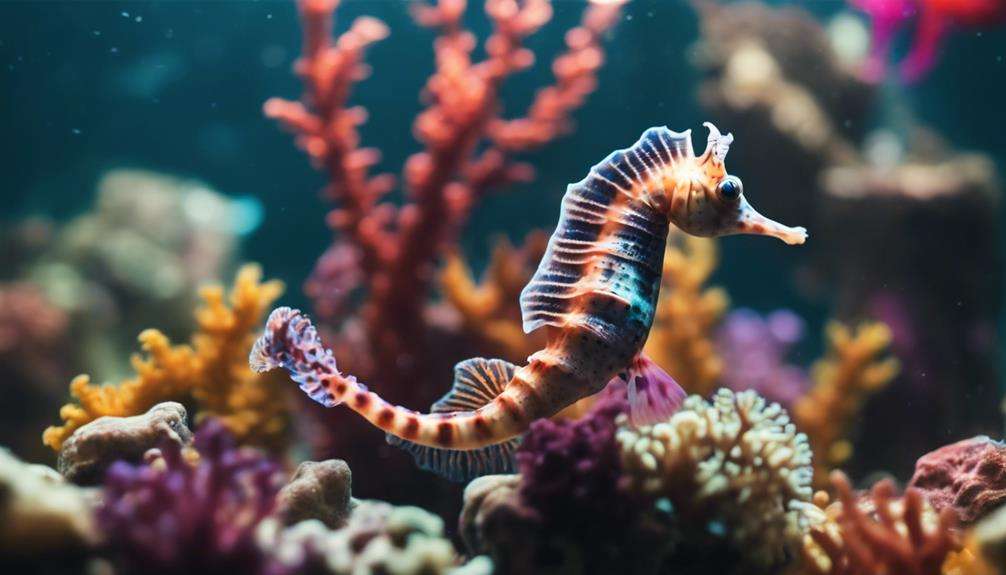
When considering suitable tank-mates for seahorses, prioritize species that align with their peaceful nature and dietary requirements. Female seahorses, in particular, require a calm environment for successful breeding. It's crucial to avoid aggressive or competitive tank-mates that may stress the seahorses or outcompete them for food.
Opt for peaceful fish species such as gobies and pipefish, which share similar temperaments and feeding habits with seahorses. Certain small shrimp species can also coexist harmoniously with seahorses. Additionally, invertebrates like snails and hermit crabs make excellent companions for seahorses in a well-established tank. These creatures help maintain the tank's ecosystem by assisting in algae control and substrate aeration.
To ensure a successful cohabitation, select tank-mates that thrive in comparable water parameters, such as temperature and salinity, to create a balanced aquatic environment conducive to the well-being of all inhabitants.
Proper Breeding Tank Dimensions
When setting up a breeding tank for seahorses, remember that the tank size plays a crucial role in their breeding success.
The recommended dimensions of 30 inches in length, 12 inches in width, and 12 inches in height provide ample space for natural behaviors and courtship rituals.
Ensuring optimal water conditions within these proper tank dimensions is essential for reducing stress and fostering successful breeding outcomes.
Tank Size Importance
To ensure successful seahorse breeding, selecting an appropriate tank size of at least 20 gallons is crucial for accommodating a breeding pair effectively. Larger tank sizes, such as 30 gallons or more, offer increased space for seahorse pairs and their offspring.
A tank with dimensions of 24 inches long, 12 inches wide, and 16 inches high is suitable for breeding seahorses, providing ample room for natural behaviors and breeding success. Opting for a larger tank minimizes stress on the seahorses and allows for optimal water quality maintenance.
The proper tank dimensions not only support breeding activities but also provide necessary space for seahorse activities and growth. Choosing the right tank size is a fundamental step in creating a conducive environment for successful seahorse breeding.
Optimal Water Conditions
For optimal water conditions in seahorse breeding, ensure the breeding tank dimensions provide a minimum of 20 gallons of space to accommodate the breeding pair adequately. Seahorses necessitate vertical tank space with a height of at least 18 inches to suit their upright swimming position.
Here are crucial considerations for selecting the ideal tank dimensions:
- Volume: A minimum of 20 gallons is necessary for breeding pairs.
- Height: Vertical space of at least 18 inches is essential for seahorses.
- Recommended Dimensions: A tank measuring 24 inches (length) x 12 inches (width) x 18 inches (height) is beneficial.
- Depth: Adequate depth is crucial for seahorses to anchor themselves and exhibit natural behaviors.
Proper tank dimensions are fundamental for creating a stress-free environment, which is vital for successful seahorse breeding.
Optimal Aquarium Decor
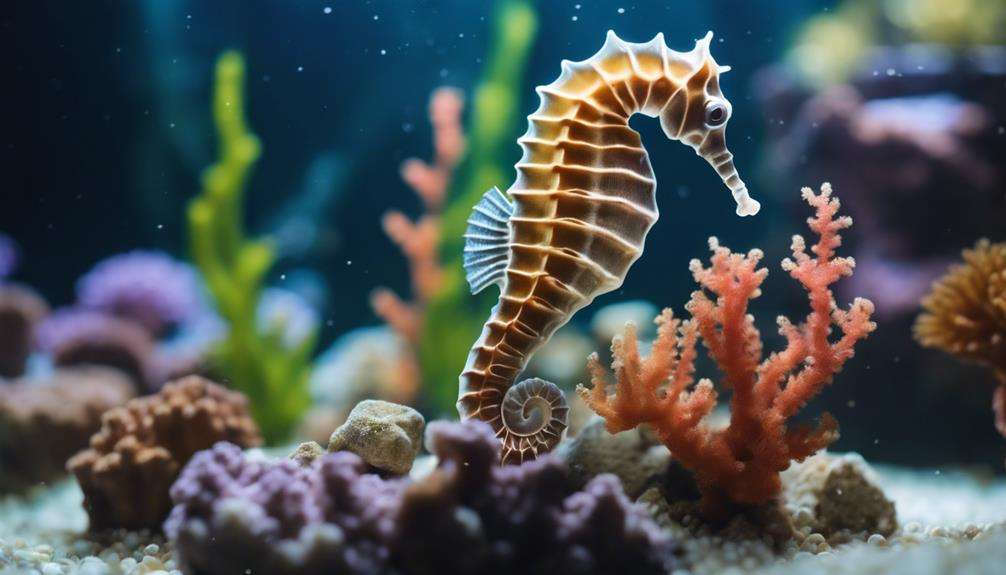
Utilizing a variety of artificial or natural holdfasts is crucial for creating an optimal aquarium decor environment for seahorses. Seahorses require structures like artificial plants, coral, or gorgonian branches to grasp and anchor themselves securely. PVC pipe sections or specialized seahorse hitching posts can be incorporated to provide vertical structures for seahorses to cling onto, mimicking their natural habitats. Live rock formations and mesh caves offer essential hiding spots and secure perches for seahorses to rest. It's important to avoid sharp or abrasive decorations that could potentially harm seahorses' delicate skin and fins.
When setting up the aquarium for seahorses, ensure that the decorations are arranged in a manner that allows for easy cleaning and maintenance. This is vital to uphold water quality and ensure a healthy environment for the seahorses. By carefully selecting and placing decorations that cater to the specific needs of seahorses, you can create an optimal aquarium decor that promotes their well-being and natural behaviors.
Managing Photoperiod Effectively
Managing the photoperiod effectively in seahorse breeding entails adjusting light cycles to replicate natural day-night rhythms, with an optimal duration of 14 hours of light and 10 hours of darkness.
To achieve successful breeding outcomes, consider the following:
- Regulate Light Intensity: Mimic dawn and dusk conditions to encourage natural breeding behaviors in seahorses.
- Utilize Timers or Automated Systems: Ensure precise and consistent control over the photoperiod, crucial for breeding success.
- Monitor Seahorse Behavior: Observe how seahorses react to changes in photoperiod to fine-tune the lighting schedule for optimal breeding conditions.
- Trigger Reproductive Activities: Properly timed adjustments in photoperiod can stimulate courtship, mating, and other vital reproductive behaviors in seahorses.
Importance of Shielded Airstones
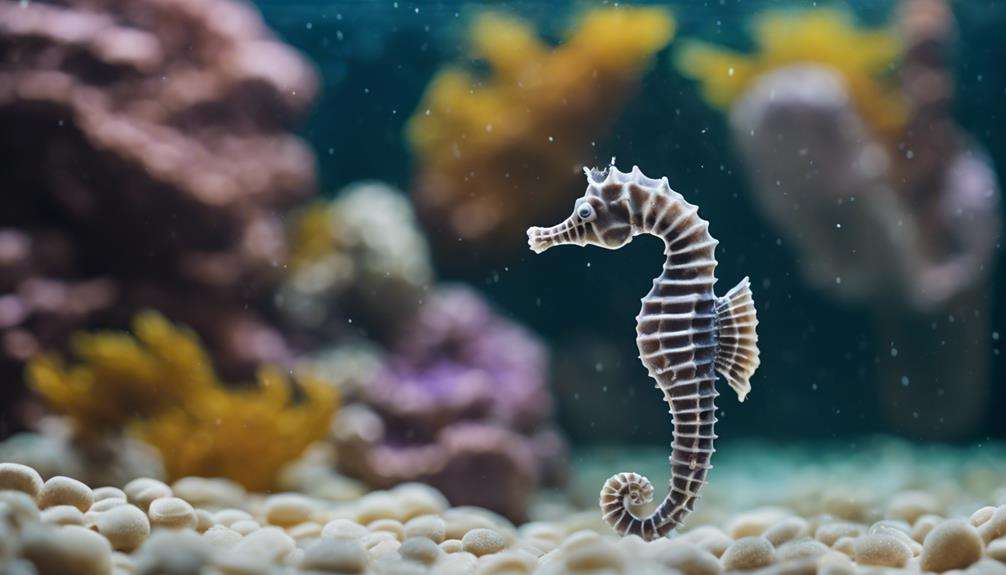
Proper placement of shielded airstones in seahorse tanks is crucial for maintaining optimal aeration levels without causing excessive disturbance.
Shielded airstones play a vital role in providing the necessary oxygenation to prevent stress in seahorses during breeding and rearing processes.
These specialized airstones are designed to disperse bubbles evenly throughout the tank, ensuring that oxygen levels are sufficient for the health and well-being of the seahorses without creating strong currents that may agitate them.
Controlling Midwater Turbulence
Controlling midwater turbulence is essential for maintaining a calm and stress-free environment for seahorses during breeding activities. To achieve this, consider the following techniques:
- Implement Baffles: Introduce baffles in the aquarium to reduce water movement and create calm zones where seahorses can engage in courtship behavior without disturbances.
- Use Sponge Filters: Incorporate sponge filters to help control turbulence levels effectively, providing a gentle and consistent water flow that's conducive to successful breeding.
- Adjustable Flow Pumps: Utilize pumps with adjustable flow settings to regulate water movement, ensuring that the environment remains tranquil for seahorses to exhibit natural behaviors.
- Avoid Strong Currents: Steer clear of strong currents that can disrupt seahorses' courtship rituals, mating processes, and their ability to carry out breeding activities effectively.
Maintaining a peaceful aquatic setting is crucial for seahorses to feel secure and for successful reproduction, including the transfer of offspring to the male's brood pouch.
Minimizing Mechanical Vibrations
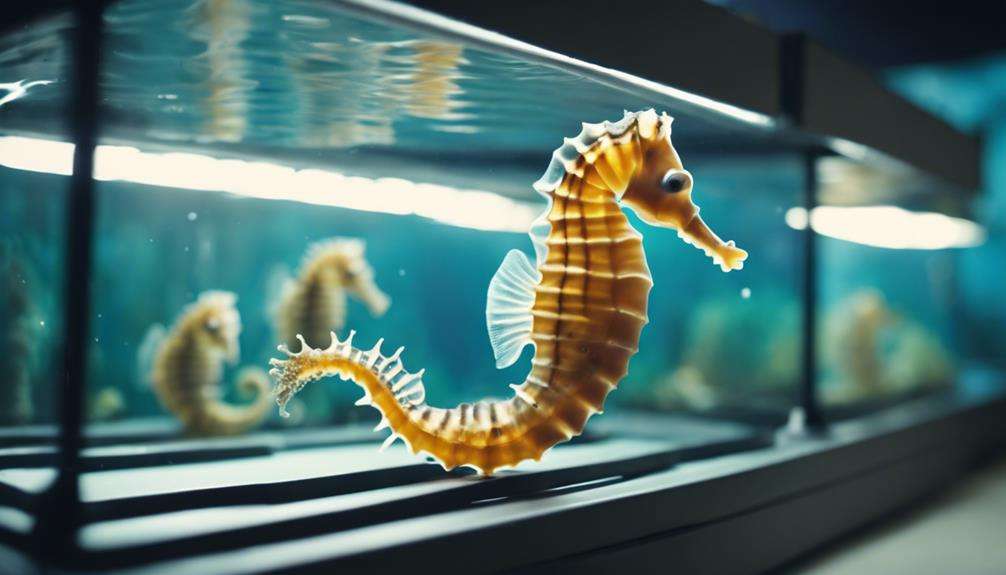
To minimize mechanical vibrations in seahorse tanks, ensure that vibration-dampening materials are utilized under equipment and loose components are securely fastened. Mechanical vibrations can disrupt seahorse behaviors critical to breeding success, such as courtship, mating, and birthing.
Excessive vibrations, whether from equipment or external sources, can stress seahorses, leading to potential breeding challenges. By using materials that absorb and reduce vibrations under equipment like pumps and filters, you create a more tranquil environment for seahorses. Additionally, securing any loose components within the tank can prevent unnecessary movement that may generate vibrations.
Consider the placement of the aquarium away from high-traffic areas or sources of vibrations to further minimize disturbances. It's vital to maintain a stable and quiet breeding environment to decrease stress on seahorses during crucial breeding stages. By implementing these strategies, you can create an optimal setting for successful seahorse breeding.
Choosing Suitable Water Conditioners
Ensure the pH levels in the tank are stable, as fluctuations can harm the seahorses.
Keep the water temperature within the ideal range for breeding success.
Choose water conditioners that are free of harmful chemicals to maintain a safe environment for your seahorses.
Water Ph Importance
Maintain optimal seahorse health and breeding success by carefully selecting reliable water conditioners specifically formulated for marine aquariums to stabilize and adjust pH levels within the critical range of 7.5 to 8.5. Proper pH levels are crucial due to seahorses' unique body structure, making them sensitive to pH fluctuations.
Here are some essential tips for managing water pH:
- Ensure pH stability between 7.5 and 8.5.
- Use marine-specific water conditioners to adjust pH levels.
- Regularly monitor and test the pH in the seahorse tank.
- Maintain suitable pH levels for the well-being, growth, and breeding behavior of seahorses.
Ideal Temperature Range
Selecting appropriate water conditioners tailored for marine aquariums is crucial for maintaining the ideal temperature range necessary for successful breeding of seahorses, typically between 72°F and 78°F (22°C to 26°C). Consistent water temperatures within this range are essential for the health and reproductive success of seahorses.
To achieve this, invest in reliable water heaters and precise thermometers to monitor and regulate the temperature in the breeding tank. Fluctuations outside the recommended temperature range can induce stress in seahorses, affecting their breeding behavior.
Frequently Asked Questions
What Are the Methods of Reproduction in Seahorse?
Seahorses reproduce through natural mating, where the female transfers eggs to the male's brood pouch for fertilization. Artificial insemination is also used in some breeding programs. The male nurtures the embryos until birth, showcasing unique parental involvement.
Is Breeding Seahorses Profitable?
Breeding seahorses might seem like chasing seashells, but lo and behold, the market demand can make it a pearl of an endeavor. Consider financial feasibility and sustainability to dive into this unique opportunity.
What Is the Easiest Seahorse to Breed?
Breeding the Hippocampus kuda, or Spotted Seahorse, is your best bet. They adapt well to captivity, have high survival rates, and exhibit strong parental care. These traits make them ideal for breeding projects despite potential challenges.
How Does Seahorse Breeding Work?
Seahorse breeding relies on intricate courtship rituals and unique parental care. Males possess a brood pouch where females deposit fertilized eggs. Through gestation, embryos develop inside the pouch, and fathers later give birth to live young.
Conclusion
In conclusion, mastering the art of seahorse breeding requires attention to detail and dedication to providing the optimal environment for successful reproduction.
By following expert techniques and implementing proper care practices, you can enhance the chances of breeding success and contribute to the conservation of these unique marine creatures.
Remember, the journey to mastering seahorse breeding is a delicate and intricate process that requires careful observation and thoughtful consideration of all aspects of their care.
